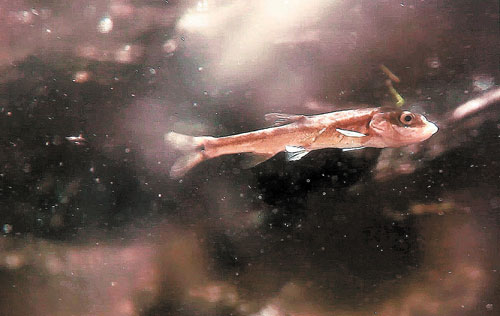Moapa dace thrives despite recent wildfire
MOAPA VALLEY -- The tiny fish with the black dot near its tail still darts through the currents of Warm Springs.
The endangered Moapa dace might have dodged a bullet from a fire that swept through this area in July.
Population numbers from the annual count last week show the dace held its ground, and its numbers are growing.
Wildlife biologists think that's because springtime rains flushed nutrients into the warm pools and channels. And, a steady increase in measures to improve the habitat over the years seems to be taking hold.
"The population has increased. We're excited about that," said Bob Williams, Nevada field supervisor for the U.S. Fish and Wildlife Service.
"The biologists were not surprised. It takes rain events, and the wetness added greatly to the overall health of the system," he said Friday.
The springs that feed the upper Muddy River, 55 miles northeast of Las Vegas, are the only place on Earth where Moapa dace live. They've been there at least since humans began recording history.
That's why biologists were worried when a 600-acre fire swept through the area last month.
A previous fire in 1994 that was blamed on a discarded cigarette engulfed a strand of 300 palm trees in and around the refuge. The population was nearly wiped out then after ashes and smoldering fronds fell in the water, raising temperatures and decreasing oxygen levels. All but 30 of about 1,000 dace in a 250-yard stretch of the springs died.
But the fire in July was contained across from Moapa Valley National Wildlife Refuge, which was established in 1979 to protect the dace. Investigators ruled that the fire was sparked by a truck driven by workers from a company hired by the Southern Nevada Water Authority to trim trees and clear away dry brush.
As the blaze raged across the road from Warm Spring Ranch, biologists had expected some loss from the fire. About 500 fish had been counted months before.
That's why they smiled when 697 turned up during the annual count last week: 37 percent more than a year ago and 30 percent more than in February.
"I just saw the most dace I've ever seen in my career in this pool," fish biologist Lee Simons said with a wide grin when he emerged Wednesday from a narrow channel below a footbridge at the refuge.
"There are over 50," he announced.
On that humid afternoon, Simons wore kneepads and snaked through the shallow channels and pools on his belly. He even crawled through the viewing area where visitors get a cross-sectional view of a spring channel.
"This science, it's not exact," he said. "We do the survey the same way every time" in an attempt to get the most accurate count.
"But we really can't count every fish. They can hide behind a rock or shoot by you. When you're looking to the left, they could shoot by to the right."
At certain points on the survey course, he reported what he had observed.
Allison Manwaring, a biologist and habitat restoration specialist, charted numbers of adult and juvenile dace.
The survey covers 16 reaches of the spring system. Other fish that share the 88-degree springs with Moapa dace were noted: White River spring fish, mosquito fish and shortfin mollies, a nonnative aquarium fish.
"When the fire happened, we went out and did a quick check and saw fish, but that didn't tell the entire story. You have to do the whole system at one time to really have an idea of what the population is doing," he said.
Simons said it's important to protect the warm waters that bubble up from the aquifer because that's where the dace breed.
"You really can't just make another stream somewhere," he said. "The temperature wouldn't be right, and they wouldn't survive. So it's a very unique fish in that way that it depends on this warm water."
He said Moapa dace is an umbrella species that plays a unique role in the ecosystem.
"No other fish has this particular life history," Simons said.
Williams said the Moapa dace population has fluctuated since the 1994 fire. It rebounded to more than 1,290 in 2005 but then dropped to about 450 in 2008. Then it was on the upswing with more than 530 charted in February.
He said springtime rains increased the nutrient-rich runoff that translates to algae and food for the fish.
In addition, biologists have done a lot of work to re-establish native plant vegetation.
Said Simons: "All that native vegetation provides a much better food base for the native species, including the dace, to feed on."
Contact reporter Keith Rogers at krogers@reviewjournal.com or 702-383-0308.
Surveying the endangered Moapa Dace




















